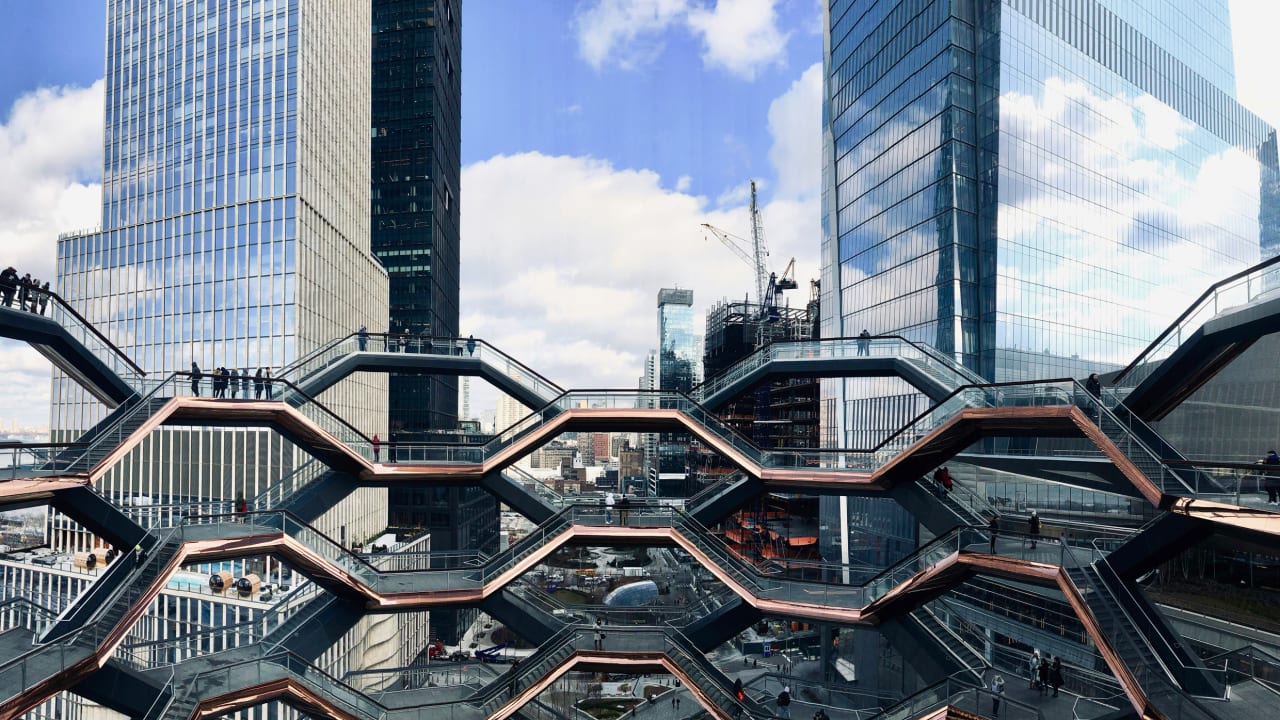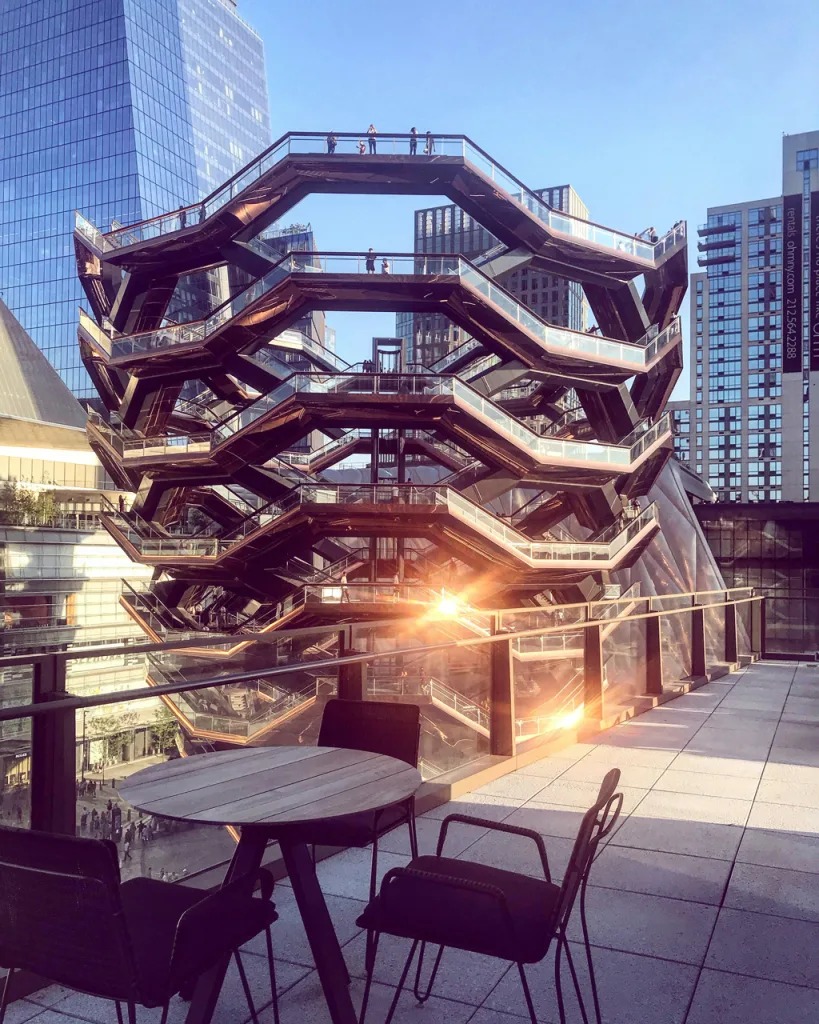The Vessel will reopen this year with mesh netting
The Vessel viewpoint, an 150-foot-tall beehive-like structure in Manhattan’s Hudson Yards, first opened in 2019. Between that year and its closure in 2021, four people died by suicide at the site. Now, Related Companies, the developer behind the Vessel, has announced that the structure is scheduled to reopen in 2024 with a new floor-to-ceiling mesh installation. The viewpoint’s top floor will remain off limits as an added precaution. The Vessel’s most permanent closure began on July 29, 2021, when a 14-year-old boy died after jumping from the structure. Before that, though, three other deaths by suicide had already taken place at the site. In January 2021, the third death initiated a brief closure, during which time new safety measures were implemented, including increased security, a buddy system, and signs with mental health resources. After just a few months, though, it became clear that those strategies weren’t enough. A spokesperson for Related told the AP that the new mesh barriers, which will encase four stairwells and their platforms on the structure’s upper floors, are designed to be cut-resistant and weather-proof. Further, they added that the barriers won’t “[compromise] the Vessel’s form or views.” [Photo: Nerise Gokpinar/Unsplash] When it opened in 2019, the Vessel’s primary barriers were waist-high glass railings around its walkways, which raised concerns from residents even prior to the tragic events that took place there. In a statement after the most recent death at the Vessel, the project’s designer, Heatherwick Studio, said that, “The team exhaustively explored physical solutions that would increase safety.” According to reporting from The New York Times, Heatherwick claimed to have conceptualized higher barriers for the Vessel which were never installed, though it’s unclear whether that was before or after the first suicides took place. (Neither Related Companies or Heatherwick Studio responded to our request for comment.) The ethics of reopening the Vessel are debatable, especially after Related’s initial attempt to boost safety measures failed. Some critics have even called for the structure’s demolition. In response to Related’s announcement of a 2024 reopening, Jessica Chait, the chair of Manhattan Community Board 4, told the blog W42ST that ensuring the safety of visitors to the Vessel “should have always been the priority above all else.” “We are relieved to see that critical changes are being made, while we remain disappointed that the commitment to open, public space has not been maintained,” Chait said. “Safety and public accessibility should have always been paramount.” According to a study by Charlotta Thodelius, a researcher at Chalmers University of Technology in Sweden, young adults (under 19 years old) tend to act on suicidal impulses more spontaneously than older adults. In those scenarios, even minimal safety measures in the built environment can make a difference. From the beginning, the Vessel could have embraced adequate safety measures without detracting from the structure’s visual presence. In 2021, Fast Company reported that other sites of multiple suicides, like the Bloor Viaduct and New York University’s Bobst Library, have incorporated creative solutions that mitigated the problem. At the Bloor Viaduct in Toronto, a kinetic metal barrier called the Luminous Veil shields passerby from the edge of the bridge while reacting to different lighting conditions. And at New York University’s Bobst Library, the Bobst Pixel Veil is a floor-to-ceiling laser-cut screen that glitters in the sun. For any tall structure—and especially for an aesthetic object like the Vessel—architects should consider safety measures and integrate accessibility concerns into design plans from the very beginning, rather than as an afterthought. Shilpa Kulkarni, the mother of the 14-year-old who took his own life at the Vessel, told the publication Our Town in the wake of Related’s reopening announcement that she wishes the company would “acknowledge our beautiful children and their lives.” “The only saving grace is if they are taking safety measures before opening then there will not be any further losses at the site,” Kulkarni said. If you or someone you know is in crisis, call the National Suicide Prevention Lifeline at 1-800-273-8255, text TALK to 741741, or visit SpeakingOfSuicide.com/resources for a list of resources.

The Vessel viewpoint, an 150-foot-tall beehive-like structure in Manhattan’s Hudson Yards, first opened in 2019. Between that year and its closure in 2021, four people died by suicide at the site. Now, Related Companies, the developer behind the Vessel, has announced that the structure is scheduled to reopen in 2024 with a new floor-to-ceiling mesh installation. The viewpoint’s top floor will remain off limits as an added precaution.
The Vessel’s most permanent closure began on July 29, 2021, when a 14-year-old boy died after jumping from the structure. Before that, though, three other deaths by suicide had already taken place at the site. In January 2021, the third death initiated a brief closure, during which time new safety measures were implemented, including increased security, a buddy system, and signs with mental health resources. After just a few months, though, it became clear that those strategies weren’t enough.
A spokesperson for Related told the AP that the new mesh barriers, which will encase four stairwells and their platforms on the structure’s upper floors, are designed to be cut-resistant and weather-proof. Further, they added that the barriers won’t “[compromise] the Vessel’s form or views.”

When it opened in 2019, the Vessel’s primary barriers were waist-high glass railings around its walkways, which raised concerns from residents even prior to the tragic events that took place there. In a statement after the most recent death at the Vessel, the project’s designer, Heatherwick Studio, said that, “The team exhaustively explored physical solutions that would increase safety.” According to reporting from The New York Times, Heatherwick claimed to have conceptualized higher barriers for the Vessel which were never installed, though it’s unclear whether that was before or after the first suicides took place. (Neither Related Companies or Heatherwick Studio responded to our request for comment.)
The ethics of reopening the Vessel are debatable, especially after Related’s initial attempt to boost safety measures failed. Some critics have even called for the structure’s demolition. In response to Related’s announcement of a 2024 reopening, Jessica Chait, the chair of Manhattan Community Board 4, told the blog W42ST that ensuring the safety of visitors to the Vessel “should have always been the priority above all else.”
“We are relieved to see that critical changes are being made, while we remain disappointed that the commitment to open, public space has not been maintained,” Chait said. “Safety and public accessibility should have always been paramount.”
According to a study by Charlotta Thodelius, a researcher at Chalmers University of Technology in Sweden, young adults (under 19 years old) tend to act on suicidal impulses more spontaneously than older adults. In those scenarios, even minimal safety measures in the built environment can make a difference.
From the beginning, the Vessel could have embraced adequate safety measures without detracting from the structure’s visual presence. In 2021, Fast Company reported that other sites of multiple suicides, like the Bloor Viaduct and New York University’s Bobst Library, have incorporated creative solutions that mitigated the problem. At the Bloor Viaduct in Toronto, a kinetic metal barrier called the Luminous Veil shields passerby from the edge of the bridge while reacting to different lighting conditions. And at New York University’s Bobst Library, the Bobst Pixel Veil is a floor-to-ceiling laser-cut screen that glitters in the sun. For any tall structure—and especially for an aesthetic object like the Vessel—architects should consider safety measures and integrate accessibility concerns into design plans from the very beginning, rather than as an afterthought.
Shilpa Kulkarni, the mother of the 14-year-old who took his own life at the Vessel, told the publication Our Town in the wake of Related’s reopening announcement that she wishes the company would “acknowledge our beautiful children and their lives.”
“The only saving grace is if they are taking safety measures before opening then there will not be any further losses at the site,” Kulkarni said.
If you or someone you know is in crisis, call the National Suicide Prevention Lifeline at 1-800-273-8255, text TALK to 741741, or visit SpeakingOfSuicide.com/resources for a list of resources.






















